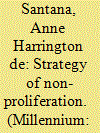| Srl | Item |
| 1 |
ID:
091667


|
|
|
|
|
| Publication |
2009.
|
| Summary/Abstract |
There are important similarities between the pattern of behavior Karl Marx identified with respect to commodities-a pattern he called "fetishism"-and the pattern of behavior identified in this article with respect to military force. Marx identified money as the mature expression of commodity fetishism; the author identifies nuclear weapons as the mature expression of the fetishism of force. As such, nuclear weapons function as the currency of power in the international system. This article lays out a theory of nuclear fetishism by adapting four themes that are characteristic of the pattern of behavior known as fetishism: materiality, historicality, efficacy, and reification. By applying these categories to the fetishism of nuclear weapons, the author shows that nuclear weapons represent a new social form consistent with, yet distinct from, other fetish objects.
|
|
|
|
|
|
|
|
|
|
|
|
|
|
|
|
| 2 |
ID:
110472


|
|
|
|
|
| Publication |
2011.
|
| Summary/Abstract |
This article criticises the leadership of the new nuclear disarmament movement in the United States for not going far enough. Whether the US administration actually wants to achieve disarmament or not, implementing the current US nuclear policy agenda will not produce a world free of nuclear weapons. Rather, it will reinvigorate an ailing non-proliferation regime by adapting it to confront new nuclear threats. This conclusion is based on a two-part argument. Firstly, nonproliferation is a strategy much like the Cold War-era strategy of extended deterrence. Just as extended deterrence required the US to maintain the credibility of an incredible threat to attack, non-proliferation requires the US to maintain the credibility of an incredible pledge to disarm. Thus, re-establishing disarmament as a credible long-term goal of US nuclear policy will persuade other states in the short term to forgo nuclear weapons and cooperate in restricting access to fissile materials. Secondly, contrary to the common-sense interpretation of the relationship between non-proliferation and disarmament, it does not follow that a robust non-proliferation regime will lead to the elimination of nuclear weapons. In fact, experience suggests just the opposite: Non-proliferation does not lead to disarmament. In conclusion, whatever the Obama administration's aim, the current US nuclear policy will reduce the threat nuclear weapons pose to the US, while obviating the need for the US to disarm itself.
|
|
|
|
|
|
|
|
|
|
|
|
|
|
|
|